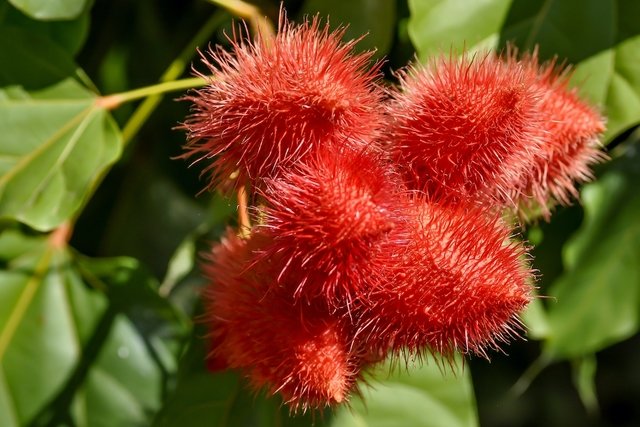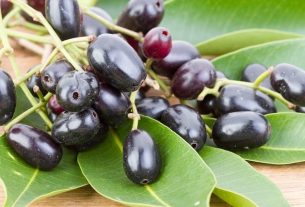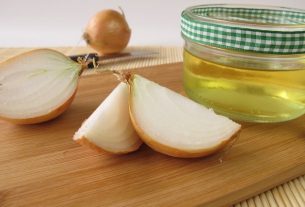Annatto is rich in carotenoids, tocopherols, flavonoids, vitamin A, phosphorus, magnesium, calcium and potassium, having antioxidant, antimicrobial and anti-inflammatory properties, and, therefore, may have several health benefits, such as strengthening bones, control blood glucose, prevent cardiovascular diseases, maintain brain health and treat skin problems, for example.
In addition to being used for its medicinal properties, annatto is also used as a colorant in cosmetic products and in the textile and paint industries. In cooking, crushing the seeds gives rise to paprika, used as a food condiment.
Annatto is a fruit of the annatto tree and its scientific name is Bixa earellana and can be purchased in supermarkets, health food stores or street markets, and it is important that its use is guided by a doctor or other health professional who has experience with medicinal plants.

What is it for
Annatto can be used for:
1. Improve eye health
Annatto is rich in carotenoids, such as bixin and norbixin, found mainly in the outer layer of the seed, and vitamin A, which are important for maintaining vision, protecting the eyes and preventing vision problems such as dry eyes and night blindness. Therefore, this plant can be used by anyone who wants to improve eye health.
2. Fight skin aging
Annatto is rich in carotenoids, terpenoids, flavonoids and tocotrienols that have a strong antioxidant action and, therefore, help prevent and combat skin aging and the appearance of expression lines, by combating free radicals that cause damage to cells. .
3. Prevent cardiovascular diseases
The tocotrienols present in annatto, due to their powerful antioxidant action, help reduce bad cholesterol, which is responsible for forming fatty plaques in the arteries and, thus, this plant helps prevent and reduce the risk of cardiovascular diseases such as atherosclerosis, heart attack or stroke. cerebral.
4. Control blood pressure
Annatto is rich in potassium, which is a mineral that helps control blood pressure, especially when it is high, because it causes blood vessels to relax, reducing blood pressure.
Furthermore, the magnesium present in annatto acts as a natural calcium channel blocker, inhibiting the release of a neurotransmitter, norepinephrine, responsible for increasing blood pressure, and thus also contributes to reducing blood pressure.
5. Regulate blood sugar
Some studies show that the tocopherols present in annatto leaf extract can improve insulin resistance, which helps control blood sugar levels and can be an important ally in the treatment of diabetes.
6. Improve the digestive system
As it is rich in fiber, annatto leaves and seeds help improve the functioning of the digestive system, contributing to good digestion and improving the absorption of nutrients by the intestine.
7. Keep your bones healthy
Annatto is rich in calcium, magnesium and phosphorus, which are fundamental minerals for strengthening, increasing resistance and maintaining bone health, which can help prevent diseases such as osteoporosis, osteopenia or rickets, for example.
8. Maintain brain health
Annatto is rich in anti-inflammatories and antioxidants such as carotenoids and tocotrienols that prevent cell damage caused by free radicals, keeping the brain healthy and helping to prevent neurodegenerative diseases such as Alzheimer’s, for example.
9. Scar the skin
Some studies show that annatto leaves have healing and anti-inflammatory properties, reducing the production of substances such as prostaglandins and cytokines, and can be used to help treat skin wounds, burns, cuts or psoriasis, for example, by accelerating skin healing.
10. Eliminate fungi and bacteria
Some laboratory studies show that annatto leaf extract is capable of eliminating fungi, especially Candida albicans e Aspergillus nigerin addition to bacteria such as:
- Staphylococcus aureus that cause lung, skin and bone infections;
- Escherichia coli that causes urinary tract infections;
- Pseudomonas aeruginosa which causes lung infections, ear infections and urinary tract infections;
- Streptococcus faecalis that causes urinary tract infections;
- Shigella dysentery that causes bacterial diarrhea.
However, studies in humans are still needed to prove these benefits.
11. Help fight cancer
Investigations carried out with myeloma cells and cancer cells of the prostate, pancreas, liver, colon, stomach, lung and skin, demonstrated that bixin, a carotenoid present in annatto, has anti-proliferative action, which means that it reduces cell growth of cancer.
Furthermore, carotenoids such as bixin and norbixin, and tocotrienols from annatto, have powerful antioxidant action, which act to combat free radicals that cause more damage to cells. However, studies in humans are still needed to prove this benefit.
Annatto nutritional information
The following table provides nutritional information for 100 grams of annatto seed:
How to use
The parts of annatto used are the leaves or seed from which its active substances are extracted. The main ways to use annatto are:
- Annatto teawhich can be made from dried or fresh leaves or annatto seeds;
- Annatto oil for cooking: mix 300 g of annatto seeds in 1 liter of sunflower oil. Heat a little until the oil turns reddish. Turn off the heat, wait for it to cool and use the oil to season salads or for cooking;
- Annatto capsules: you can take 1 annatto capsule of 250 mg, up to 3 times a day, before meals. These capsules can be purchased at pharmacies, drugstores or health food stores.
Another way to use annatto is in ointments, which are made with the extract of this plant and can be purchased ready-made in pharmacies or drugstores, used to heal the skin, in cases of psoriasis, wounds or burns, for example. However, it is important to consult a doctor before using the ointment.
How to make annatto tea
Annatto tea can be made using the leaves or seeds.
Ingredients
- 8 to 12 dry or fresh leaves or 1 tablespoon of annatto seed;
- 1 liter of water.
Preparation mode
To make annatto tea, you must boil 1 liter of water. Once boiled, remove from heat and add the leaves or seeds, leaving for around 10 to 15 minutes. Then strain and drink 2 to 3 cups a day.
Possible side effects
Annatto is safe for most people when used in the form of a skin ointment or consumed as paprika in small amounts in food.
For annatto leaves, it is recommended to use up to 750 mg per day for a maximum of 12 months and, for the seeds, prolonged use should be avoided as there is not enough information to know if they are safe or what the side effects may be. .
Annatto can cause allergies and medical help should be sought immediately or the nearest emergency room if allergic symptoms such as difficulty breathing, nausea, vomiting or convulsions appear.
Who shouldn’t use
Annatto should not be used by pregnant or breastfeeding women as there are not enough studies to prove its safety. Furthermore, people undergoing surgery should also avoid using annatto, as it can alter blood sugar levels.
Furthermore, annatto should be used with caution by people who use diabetes medications such as glimepiride or insulin, for example, as it can cause a sudden decrease in blood glucose and lead to the appearance of symptoms of hypoglycemia such as excessive sweating, nervousness, agitation, tremors , mental confusion, palpitations or fainting.
Annatto should also not be used by people who have kidney failure or who are taking medications to treat hypertension and diuretics.

Sign up for our newsletter and stay up to date with exclusive news
that can transform your routine!
Warning: Undefined array key "title" in /home/storelat/public_html/wp-content/plugins/link-whisper-premium/templates/frontend/related-posts.php on line 12
Warning: Undefined array key "title_tag" in /home/storelat/public_html/wp-content/plugins/link-whisper-premium/templates/frontend/related-posts.php on line 13




